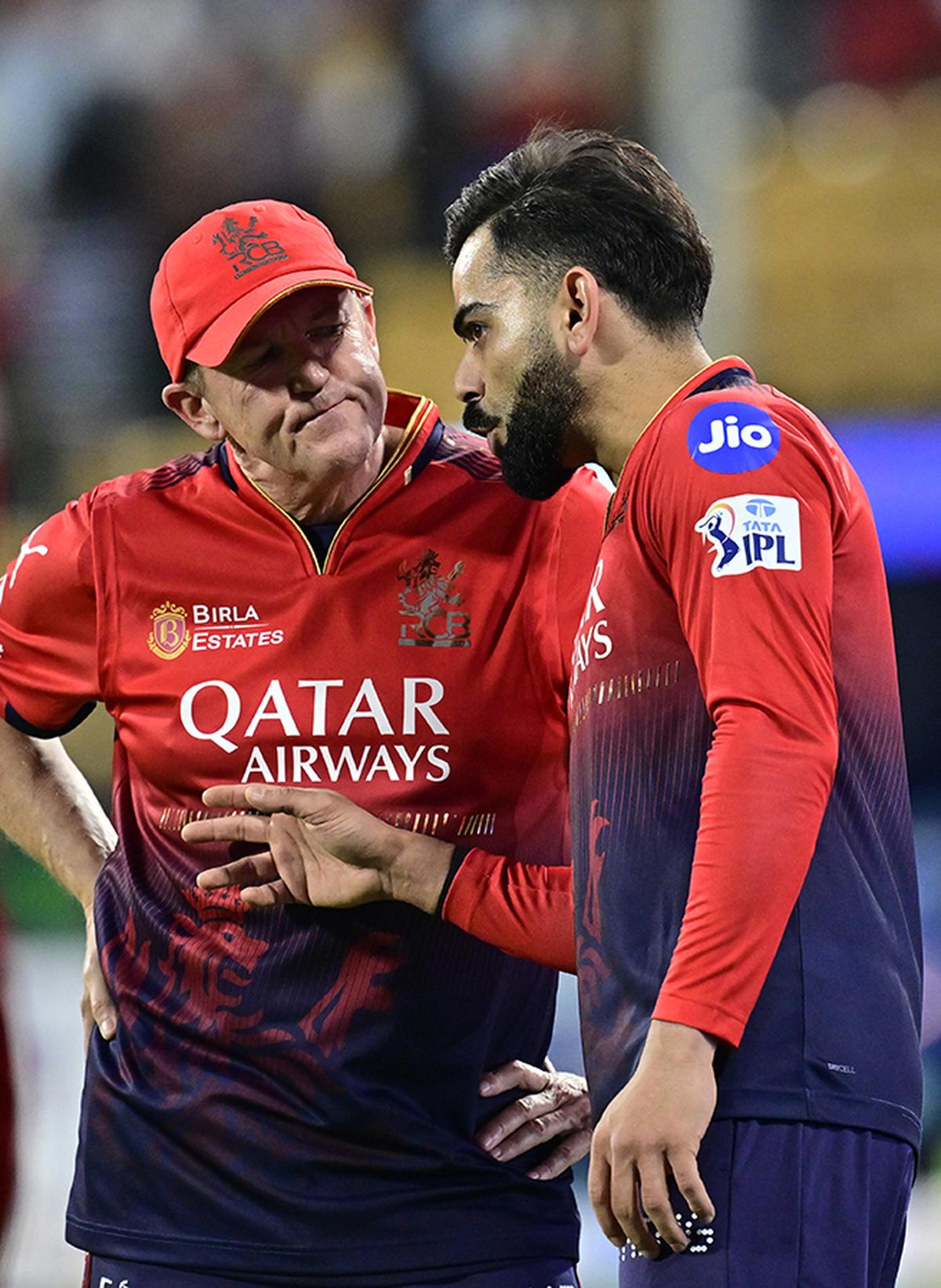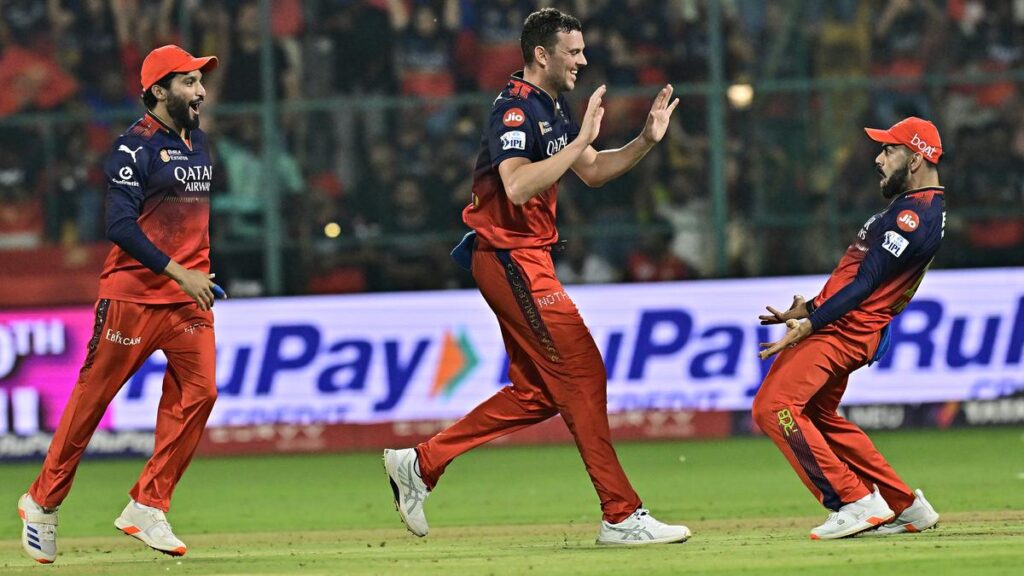Having whipped a full toss from Yash Dayal nonchalantly behind square, he followed the path of the ball unblinkingly, knowing from the moment it made contact with the bat where it was headed. Still, typical of the man, he waited for confirmation. As the ball screamed over the boundary buntings, over the fence and into the stands where a dozen hands reached out to grab it, he drew a circle on the ground, plonked his bat in it and let out a roar. All atypical. Then came the piece de resistance: ‘This is my ground.’
Much like his illustrious namesake from the same city, K.L. Rahul is all about control. Of his emotions, as much as anything else. And much like Rahul Dravid did at the Eden Gardens in 2001 during that Test against Australia on reaching his hundred – he whipped off his helmet and made repeated pointed gestures in the direction of the commentary box – the younger Rahul let his hair down at the M. Chinnaswamy Stadium a little over a fortnight back after hauling his latest franchise, Delhi Capitals, over the finish line against his former, and first, franchise, Royal Challengers Bengaluru.
Only Rahul will be able to spread light on his uncharacteristic celebration at getting the job done. One of the popular theories is that he was ‘giving it back’ to RCB, who had let him go unceremoniously several years back, and who didn’t make more than a token attempt to bring him back even though he was very much a successful son of the soil and the Bengaluru franchise had little-to-token ‘local’ representation.

RCB. It’s a name synonymous with Virat Kohli, much like Chennai Super Kings are with Mahendra Singh Dhoni and Mumbai Indians with Rohit Sharma. All champions who have led the country with distinction, the last two having led their respective franchises too to a record five IPL titles apiece. And yet, of this trio, only Kohli has stayed with the same franchise all these years. Since the start of the league in 2008. Forget this trio, in IPL history, no other player has represented the same side for 18 years on the bounce. Rohit started his career with Deccan Chargers, with whom he won the title in 2009, while Dhoni played for Rising Pune Supergiant(s) in the two years (2016 and 2017) when CSK were banned.
It’s therefore inevitable that RCB will be identified with Kohli, and vice-versa. True, in the very early days when T20 cricket itself was in its infancy and the IPL was a new-born whose potential was a mystery, such worthies as Dravid and Anil Kumble played for, and led the franchise. Kumble, who took over mid-season in South Africa in 2009 when Kevin Pietersen returned to England on international duty, even shepherded the outfit to the final, where RCB succumbed to Rohit’s Chargers, led by Adam Gilchrist. But for the modern generation, Dravid and Kumble are more easily identifiable as national head coaches and analysts than
RCB alumni because, after all, public memory is short, fickle, unpredictable.
Unless, of course, you are talking Kohli and RCB. Fans in Bengaluru, indeed fans of RCB anywhere in the country and beyond – and there are millions, let’s not make any mistake – take offence, umbrage even, when one points out that for all of Kohli’s ‘genius’, he is yet to wrap his hands around the title. He was captain for nearly a decade, he had at his disposal some of the greatest white-ball batters of all-time – including Chris Gayle, A.B. de Villiers, Shane Watson and Yuvraj Singh – and still doesn’t have any silverware to show, one reminds them. What were the rest doing, they shoot back. How much can one man do?
Hard to fathom
It’s hard to rationalise this relationship between a generally genteel city and an emotional, heart-on-his-sleeve Delhiite who often stays true to the adage that you can take a boy out of Delhi, but you can’t take Delhi out of the boy. Bengalureans love to love ‘Virat’ – only first name please – and are willing to go to any lengths to overlook any indiscretion, including his shoulder charge of debutant teenager Sam Konstas in the Melbourne Test last December. ‘What was he fined? 20% of his match fee? Minor offence. An accident,’ they insist. The International Cricket Council, it would seem, endorses that view.
RCB are one of three original franchises never to wear the IPL crown. Like Delhi Capitals (formerly Delhi Daredevils) and Punjab Kings (once Kings XI Punjab), they have gone from Bangalore to Bengaluru behind Royal Challengers in the last couple of years. It’s perhaps the only concession they have made to their home base, though this year, they have welcomed back Devdutt Padikkal, the rangy left-hander whom they have used as an Impact Player with stunning results.
Different vibe
This year. Well, it has been different. There is something about RCB that compels, commands, demands attention. Most of it has to do with Kohli, of course (how can it not?). But not all of it. Certainly not.
This is as good a start to the season as RCB have enjoyed in recent times. It’s a far cry from last year when, after eight games, they had just one win and two points to show. Written off as no-hopers (who could blame those writing that?), they rose like the proverbial Phoenix from the ashes, stringing together six successive wins to make the playoffs as the fourth-placed team, ahead of CSK on net run-rate. Their campaign ended in the Qualifier when they went down to Rajasthan Royals, but hey, what a ride that was!
RCB have started 2025 much like they ended the previous season. Where they had two points after eight games then, they boasted 10 this time, which has since burgeoned to 12 from nine outings. Kohli has been at the forefront of their dynamic run, as is inevitable – he is once again battling for the Orange Cap that adorns the head of the highest run-getter – but this time around, it hasn’t been only about Kohli and the rest.
That it wouldn’t be so became apparent at the November mega auction in Jeddah when RCB strung together a balanced, powerful, all-weather team. Perhaps the only doubts revolved around their spin department – Krunal Pandya and the largely untested Suyash Sharma – but even that has delivered, with left-armer Krunal already equalling his record for most wickets (12) in a season and his leg-spinning counterpart playing his part to a nicety.
Once top-heavy and relying mainly on Dinesh Karthik in the last few years to do the heavy lifting in the later stages of an innings, there is a greater levelling out of riches. Kohli has a super-aggressive opening partner in Phil Salt, who struck up such a wonderful tandem with Sunil Narine when Kolkata Knight Riders won the title last year, while Padikkal at No. 3 has been sublime and silken smooth. Kohli himself has upped his strike-rate considerably, especially against spin where his slog-sweeping has opened up an exciting new vista. Rajat
Patidar, potentially RCB’s least glamorous captain ever, has pulled his weight but the game changers have been Jitesh Sharma, the creative wicketkeeper-bat, and Tim David, the extraordinarily powerful Australian who has been a magnificent addition towards the closing stages of an innings.
Optimum use of resources
This spreading out of the resources and the fact that they can bat aggressively without compromising on balance till No. 8 has translated to a string of big scores and comfortable wins, primarily away from home until last week, when they topped 200 against Rajasthan to register their first win at the Chinnaswamy in four attempts in 2025. Even their tally of 205 didn’t seem adequate until Josh Hazlewood, one of the key buys in the auction, reiterated his class with three for seven in overs 17 and 19 combined.
Pitches at the Chinnaswamy, once wonderful for batting, have been more demanding this year, though the one used for the Rajasthan game was truer, pacier and bouncier than the previous three. Hazlewood used his height to grand effect but refrained from being predictable, mixing up his pace and length to lead a balanced and versatile pace pack that also comprises the experienced Bhuvneshwar Kumar, the left-arm exponent Dayal and Rasikh Dar, who has been sparingly used.
Of course, past history stands testimony to the fact that no matter the names that dot the landscape, it’s performances that count and Patidar can afford himself a pat on the back for getting his more eulogised colleagues to contribute not just in their primary disciplines but also in a leadership capacity. Collectively,
RCB have that look in their eye, if you know what we mean. There is a sense of purpose and narrow focus (about time, you say?) and everyone knows that they won’t beat themselves.
Rahul’s match-winning half-century was the middle of three home games where RCB were punished by Prodigal Sons, perhaps determined to prove a point. If it was Mohammed Siraj (who played for RCB
for seven seasons) who did the damage for Gujarat Titans, then Yuzvendra Chahal (the leggie with more than 50 IPL wickets at the Chinnaswamy) fuelled Punjab Kings’ charge after Rahul had done the trick for the Capitals. Fortunately, RCB found ways to quell former stars Wanindu Hasaranga and Shimron Hetmyer from following suit for Rajasthan – where Dravid is now the head coach – in a further indication that this year, this RCB, could just about go where no RCB team has gone before.
To fall back on a much-abused cliche, the IPL is a marathon, not a sprint. Even though it is into its fifth week, there is still a long way to go. Things will get trickier from here on, but RCB appear to have several tricks of their own still up their sleeve. Ee sala…, finally?
Published – April 27, 2025 10:40 pm IST

